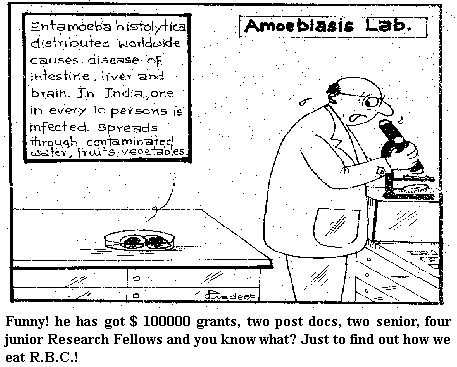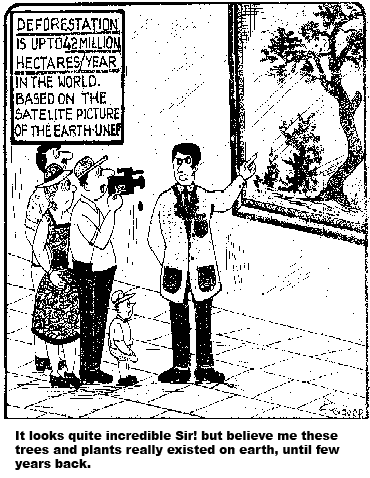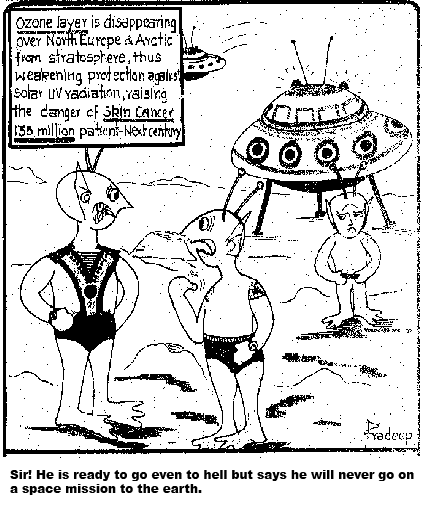|
Indian Journal of Science Communication (Volume 1/ Number 1/
January – June 2002) |
<< Back
|
Scientoons : A
Novel Tool of Science Communication
Pradeep K. Srivastava
Scientist, Chemical Technology Division, Central Drug Research
Institute, Lucknow - 226 001 |
Background
A cartoon is a combination of caricature i.e. funny drawing and
satire i.e. funny saying. A caricature is the distorted presentation
of a person, type or action, which looks funny. The word caricature
is derived from Italian verb ‘caricare’ which means to load or to
surcharge with exaggerated details. Mosini was probably the first to
use this term. Gian Lorenzo Bernini introduced the world
‘caricatura’ in France when he went there in 1665. Caricature was a
product of renaissance and reformation emphasis on the importance of
individual.
Satire is a humorous comment, which may be quite thought provoking.
Cartoon is a capsule version of any event involving the extreme
economy of language. Cartoon is based on the wide acqaintance of the
subject.
In the middle nineteenth century a monthly sheet of caricature began
publishing in London in 1830. Famous cartoon magazine Punch got
started publishing in 1841. Famous cartoon magazine College Humour
was published in 1920’s and 1930’s. New Yorker began publishing in
1925.
 |
Science and satire
A number of scientific journals viz. CHEMTECH (USA), TIBS (UK),
New Scientist (UK), Science (USA) and many more are publishing
science cartoons and also science comic strips. Current Content
(USA) also publishes a cartoon almost in its every issue.
In India, R.K. Laxman the famous cartoonist of the Times of India
has drawn a number of science cartoons which were published in
Science Today for many years. A collection of his science cartoons
are published in a book entitled ‘Science Smiles’. Sudhir Dar,
another famous cartoonist, also touched science in his cartoons.
Science Reporter is including science cartoons in its issues. Other
magazines publishing science cartoons include Vigyan Pragati,
Electronics for You, Bulletin of Sciences, etc.
 |
Science through
scientoons
Scientoons are a novel class of science cartoons which not only
makes you laugh but also carries some scientific information,
message or attracts your attention towards a problem in a thought
provoking way. The term ‘Scientoon’ was coined by the author in
1988, while delivering a lecture on the topic ‘Development of drugs
and pharmaceutical industry in developing countries’ in a conference
held at the National University of Singapore. Royal Swedish Academy
and Swedish National Committee for Science and Technology, which
organised ‘32nd International Union of Pure and Applied Chemistry
Congress’ in 1989 at Stockholm, Sweden, accepted a research paper
entitled ‘Scientoon’ for presentation at the congress. This paper
explained that how scientoons can be used to educate the people
about the various rules and phenomena of chemistry.
In 1990, the author started using scientoons for explaining and
highlighting various environmental issues, concepts and problems.
United Nations Environment Programme published a report on this
novel approach in its Asia-Pacific Newsletter. Use of scientoons in
lectures made the whole information interesting and easily
understandable even for the people who did not have scientific
background. Over 60 lectures have been delivered by the author to
the varied audience like scientists, doctors, engineers, health
workers, executives, police and army officers, students, botanists,
etc. in India, Thailand, Singapore and USA.
In 1993, the author chose an important analytical technique ‘mass
spectroscopy’ for delivering lectures using scientoons. This was a
unique attempt to explain a highly technical subject in a very
simple and interesting manner through scientoons.
 |
Enjoying science
Scientoons have revolutionised the way science can be
communicated by making complex and highly technical science
subjects, simple and easily understandable. It is undoubtedly a
great contribution towards communicating science by making science
understandable and enjoyable to common man and experts alike.
Scientoons hold a great future ahead and a science has a lot to
promise to common man through scientooning to understand, enjoy
science and inculcate scientific temper and generate mass interest
in science.
References:
-
Encyclopaedia
Britanica, Vol.3, pp. 909.
-
Science Smiles, IBH
publishing House, Mumbai.
-
UNEP Newsletter,
8(2), April-June 1991.
-
Chemtech, 1991,
American Chemical Society, USA.
<< Back |